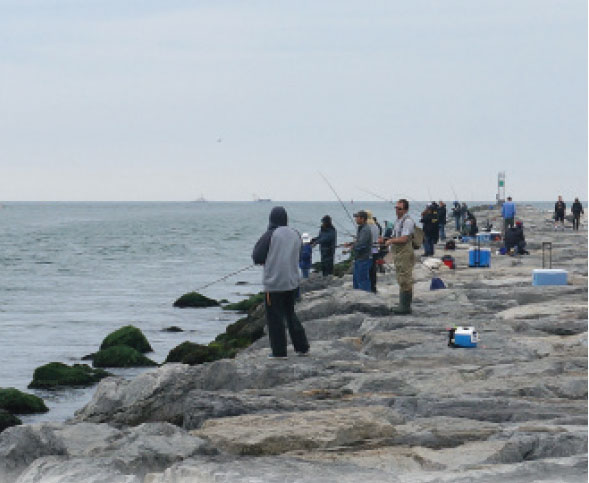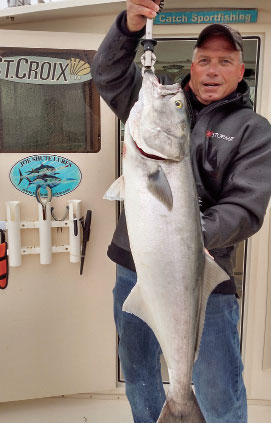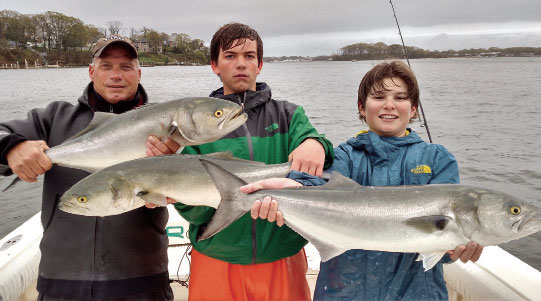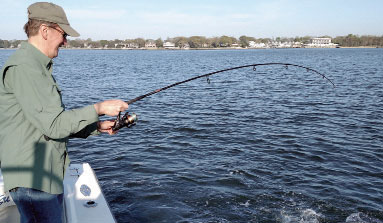
From Indian River in Delaware to the wide open expanses of Raritan Bay, the April return of hungry bluefish is sure to test your tackle.
The 2016 spring migration of bluefish was without a doubt one for the record books as mammoth bluefish flooded into our back bay waters.
After tearing up the Delaware coast and ripping their way through Cape May County, the first bluefish came through the Manasquan Inlet on April 24 and were caught by anglers fishing over the rail. That day marked the beginning of a month long epic event, one that any angler I spoke to said was nothing short of incredible and something they had never experienced before.
Bluefish flood into the back bays and rivers every spring but what made this event so incredible were the size of the bluefish and the length of time that they stayed. All the bluefish were by party boat standards very big. Day in and day out we were commonly catching 12- to 15-pound bluefish with some bigger. The largest bluefish that I know of that was weighed in locally in my area was 24 pounds. On my boat I had one that was a legit 20 pounds; these big blues stayed right up until Memorial Day weekend.
Normally the class of bluefish we see in the spring are 6 to 12 pounds and their body appearance is different from what see in the fall. They are commonly referred to as racers as they look like sleek torpedoes. For the time being they have a long slender body that is in disproportion to their normal sized much larger head. Upon entering the warmer back bay waters, they will race around devouring anything in their path to build their fat reserves back up that have been depleted after a cold winter. They will feast on an array of baits such as spearing, anchovies, herring and adult bunker.
Last season we even had blues spitting up cinderworms that they ate during the May worm hatch!
Home Court Advantage

Usually Raritan and Barnegat bays take center stage for this action but last season I wouldn’t want to be any place other than the Manasquan River. If you could call blue fishing world class, then we had it. As I said every day we had these fish without fail. The blues were stretched out from the back of the Inlet along Dog Beach down to the west side of the Route 70 Bridge. The area around Treasure Island became the focal point of the action. We were catching these big blues in 1 to 4 feet of water. And what made it so much fun and exciting was that we were catching them by casting topwater poppers or swimming plugs on light tackle.
This was an absolutely addicting event as a short quarter mile run from my dock at Will’s Hole Marina in Point Pleasant resulted in instant hook-ups on just about every first cast. Double and triple-headers were common. As many anglers that I had on board to cast plugs everyone would connect and come tight on the first cast. As fast as you could release the blues was as fast as you could catch another. Since the Manasquan River is a small estuarine system you didn’t have to search very much to find the blues. It was like fishing in a giant self-contained fish bowl.
There were also many oil slick calm days in the late afternoons when the blues could be seen finning just below the surface. Their dorsal and tail fins peeking and undulating just above the surface were the telltale signs that they were there in packs. This looked just like their summer offshore behavior when we see them on top in their spawning ritual when we are on the tuna grounds. Sneaking up to them with the boat in stealth mode and then placing a cast just behind them and retrieving it back through them made for explosive action.
Look to the West
Regardless of which water system you are looking for big blues in the spring the most productive waters are usually found away from the ocean. Incoming tidal waters in the spring bring in much colder ocean waters, which can drop water temperatures about 10 degrees on the eastern side of a bay. Also the western shorelines with a southerly facing sun exposure will warm the quickest as the sun bakes the darker mud bottoms.
Keep in mind that the outgoing tides when they occur in the afternoons will always have the warmest water of the day so a quick run out after work can be highly productive. If you are fishing around the inlets, then the outgoing tides will definitely work in your favor as this is when any staging fish can intercept baits that are being flushed out to the ocean.
So much is said and written about the striped bass as being the prized trophy of the New Jersey angler that the bluefish is often neglected and given a bad rap. But pound for pound the bluefish is equal to and in many cases exceeds the expectations of even the most experienced angler when it comes to hooking a great fighting fish on light tackle. Big bluefish like the size we saw last season no doubt met up to this expectation.
Bluefish are an extremely hardy fish so catching them on light tackle is not going to cause any undue harm upon them. Most of the time the damage to the fish comes when one is trying to remove the hook and not from the fight itself. For this reason, one should replace tailing treble hooks with a single long shank j-hook and crush down the barb when using artificials. Also the head and or middle treble hooks on any plugs can just be removed. These hooks are not even necessary when fishing for bluefish because blues normally attack a bait from the rear biting off its tail to immobilize it before they come in for the kill.

The Blue Battalion
My go to light tackle spin rod is the 7-foot St. Croix Legend Trek or Avid Series medium power fast action rod. These rods are extremely light and have a great feel to them and are ones that you can cast all day without getting tired but still generate enough power to pull in and subdue a 15- to 20-pound bluefish. Spinning reels are spooled with 30- to 40-pound braid with a 10-foot shot of 30-pound monofilament leader. Wire is not necessary when we are casting 6- to 8-inch swimming plugs or poppers as the length of these artificials keeps the mouth of the bluefish far enough away from the leader when they bite.

Sometimes however it will be other blues that will swipe at the plug on the hooked bluefish and inadvertently hit the leader. If this is happening or if you are using smaller length metals or artificials then tie on a 12-inch piece of 30- to 50-pound tie-able wire leader such as Rio Powerflex Wire Tippet or Tyger wire. These can be tied using conventional knots such as the improved clinch or albright knot to your lure. You connect the tie-able wire to your mono leader with a loop to loop connection. Last season the SP Minnow was my hot go to plug as it always produced strikes. But switching to topwater plugs or flies was also a fun option as the explosive surface action is always exhilarating to watch.
When fly fishing I like to employ the old bait and switch method. To do this I will cast out a hookless popper on spin tackle and work it across the surface. As I do this blues will start crashing behind it as I draw them close enough to the boat so my client can reach them with the fly. When they are just about in range the popper is pulled out quickly and the cast is made to that spot. Usually an instant hook-up results. Bob’s Bangers work best for this method.
As with any fish in the ocean or bay the bluefish should be treated with respect. Take care in releasing any bluefish not slated for the grill or dinner table as they can be handled safely by tailing them or with a Boga grip.



